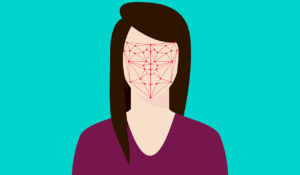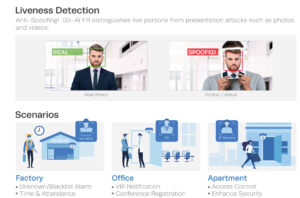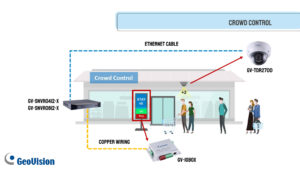
Selecting a facial recognition-based access control solution has never been more difficult than now, as an increasing number of vendors enter this market. In this article, we provide you a comprehensive guide on how to select a facial recognition access control system for your organization.
There are several advantages to choosing facial recognition, and they go beyond limiting the spread of the COVID-19 virus. According to a digital transformation consultant with over 17 years of experience providing security integration services in the Middle East, the most attractive feature is the speed. A good quality facial recognition system would be faster than a fingerprint reader in granting or denying access.
But the current demand for facial recognition solutions has prompted many manufacturers to enter the segment. For customers, this means choosing the ideal solutions is not a simple process. A clear understanding of the specs is imperative for making the right decision. Perhaps more importantly, customers should also know if a manufacturer makes their products themselves or gets it from an OEM. Products from a vendor who designs and manufactures on their own are more likely to be unique and reliable.
Having said that, here are some of the major factors to look for when purchasing a facial recognition access control solution.
1. Lighting and temperature for outdoor use
If you plan to install your face recognition access control outdoors, direct sunlight or other forms of light from behind a person are factors to consider. Such strong light could affect the accuracy device or slow it down. Check with the manufacturer what would be the ideal lighting conditions for their product to work.
If you need to make changes to your current lighting conditions, you might want to factor in the costs of that before making a decision. But light is not the only concern when you install outdoors. You should also consider the ambient temperature factor.
If you install the device outdoors, it could be exposed to high temperatures that may cause many devices to crash. So usually, when choosing face recognition-based access control products for outdoor applications, you must choose stable and reliable products designed for use in higher temperatures compared to indoors.
2. Anti-spoofing technology

For facial recognition access control systems to work, the device should be able to differentiate between a real face and a picture of a person. This feature is known as anti-spoofing and any customer wants to purchase a facial recognition solution should make sure the vendor provides this.
3. Speed

The solution should recognize and process a face in at least one second. This is important in normal circumstances for convenience but even more crucial during a pandemic like COVID-19, where social distancing is necessary.
The main reason that customers should consider the recognition speed is to avoid the aggregation of people caused by the slow recognition speed.
However, a problem that is often seen is that when the number of faces that a solution needs to process is high, there is often a slowdown.
We have seen this in fingerprint readers as well. Vendors would say their readers can process within one second, which may be possible if your customer has a company with 50 or 100 employees. But when you have a thousand or more users, that one second becomes two, three, or more seconds.

4. Recognition accuracy
Over recent years, the accuracy rate of facial recognition has increased rapidly. According to the National Institute of Standards and Technology (NIST), as of April 2020, the error rate of the best facial recognition solution is now 0.08 percent compared to 4.1 percent in 2014. Customers should find out the accuracy levels of the device they intend to purchase while keeping in mind that speed and accuracy are dependent on the conditions.
5. Ensuring cybersecurity
The data that an access control solution collects needs to be secure so that the privacy of people and the company remains intact. However, the problem with this, according to some experts, is that many access control solutions use an interface that’s not secure.
One of the cons of facial recognition-based access control solutions is that the final-mile connection to the access controller is not secure, even though biometric identification is secure. Most access systems use the standard Wiegand interface, which is not secure. But many are unaware of this, and this information is not always shared with customers.
It is recommended that to use solutions that use the Wiegand connection with AES encrypted RS485 communication or OSDP (Open Supervised Device Protocol) protocol for secure communication.
6. Face recognition under complex conditions

Traditionally customers have raised questions on accuracy levels when a person wears glasses or has a beard. But now, the question is if the solution can recognize and verify a person wearing a mask.
A drawback in many facial recognition solutions today is that people have to remove their masks for it to work. But many companies claim that their solution will work even if a person is wearing a mask. In the current context, customers may want to consider this feature as well.
7. Multimodal authentication
For any access control solution to be fool-proof, it should have more than one modality. Facial recognition could be the primary mode for the solution, but another modality like RFID card reader or palm vein should accompany it. This will come in handy if the system has difficulty with certain faces and is not sure of their authenticity, as it can resort to a secondary verification method. Usually, it’s difficult to beat two modes of verification.
In the following scenarios, various authentication methods such as the face, fingerprint, card, and iris could improve the accuracy rate and security:
• Scenarios with high-security requirements, such as banks
• To recognize personnel with accessories such as headscarves and masks
• More complex scenes in the external environment
8. Temperature measurement option
Finally, COVID-19 has forced companies worldwide to monitor staff’s and, in some cases, customer’s body temperatures. Markets are witnessing a spike in demand for temperature monitoring cameras. As this becomes a new normal, including it in the access control system would make things far more convenient than having someone point a temperature gun every day. Customers should make this is a selection-criterion.
Whether a facial recognition solution has the function of temperature measurement is something customers should be concerned about, especially during a pandemic. Often customers look at only a few features when selecting a product. Ideally, they should find out if the solution meets all the criteria.
A closer look at the growing demand
Asian markets have, for the most part, embraced facial recognition despite an initial reluctance due to the low accuracy and concerns for privacy. The demand has increased dramatically over the last two years, and possibly have replaced fingerprint as the dominant, if not preferred, biometric authentication method.
For high-security areas, facial recognition is also being seriously considered with an additional factor, mostly a smart card. The de facto design used to be fingerprint with pin or card. A big breakthrough is possibly the mass adoption of facial recognition by the fintech industry, especially fuel by the Chinese e-payment system. That created a lot of confidence for the electronic security customers.
While the initial positive response to this technology was more in Asia, the COVID-19 epidemic has accelerated the application of face recognition products in the rest of the world as well. More and more customers have begun to use face recognition-based access control systems to ensure the safety of people entering and exiting, and this, in the short term, will usher in explosive growth.
Adapted from a&s Magazine



































































